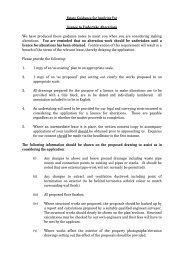Chelsea Insider Low - Cadogan
Chelsea Insider Low - Cadogan
Chelsea Insider Low - Cadogan
- No tags were found...
You also want an ePaper? Increase the reach of your titles
YUMPU automatically turns print PDFs into web optimized ePapers that Google loves.
14 | STREETS & SIGHTS |lived at number 16 for 20 years from1862, and kept a menagerie of animalsthere, including armadillos, kangaroosand peacocks – much to his neighbours’distress.He was particularly fond of wombats,which he described as ‘a joy, a triumph,a delight, a madness’. He even lamentedthe death of one in a pen drawing and averse: ‘I never reared a young wombat,to glad me with his pin-hole eye, Butwhen he was most sweet and fat, Andtail-less he was sure to die’ – a parodyof Irish poet Thomas Moore’s Lalla Rookh.Algernon Charles Swinburne andGeorge Meredith also lived with himat the house at various times.• Victorian author George Eliot (1819-1880), who wrote novels includingMiddlemarch, Daniel Deronda, SilasMarner and The Mill on the Floss, movedinto number 4 with her new husband in1880. She died there later that year of akidney infection. She used a male penname rather than her own name, MaryAnne Evans, because she thought itwould help her work to be taken moreseriously.• The American artist James AbbottMcNeill Whistler (1834-1903) lived atHenry VIII’s <strong>Chelsea</strong>manor houseRoyal Borough of Kensingon & <strong>Chelsea</strong>, Family & Children’s Serviceseveral addresses in <strong>Chelsea</strong> including 96Cheyne Walk, where a plaque bears hisname. He was known for his wit and wasfriends with Oscar Wilde. A sculpture ofWhistler by Nicholas Dimbleby stands onCheyne Walk near Battersea Bridge, at apoint affectionately known as Whistler’sReach. He signed his works with a butterflyimage and painted scenes around thearea, including Nocturne: Blue and Gold –Old Battersea Bridge, and Nocturne inBlack and Gold – The Falling Rocket(see Art).• Number 10 housed one of the 20thcentury’s key politicians, David LloydGeorge (1863-1945) – the only Welshprime minister and the last Liberal to holdthe office. He was PM between 1916 and1922, and was one of the ‘big three’(along with France’s Georges Clemenceauand US President Woodrow Wilson) whofinalised the Treaty of Versailles, signed inJune 1919, that ended the state of warbetween Germany and the Allied Powersafter the First World War.• Scottish sculptor John Tweed (1869-1933), known for statues including LordKitchener at Horse Guards Parade, thepeers’ war memorial at the House of Lordsand Joseph Chamberlain in WestminsterAbbey, lived at 108 Cheyne Walk.• Poet, essayist and historian HilaireBelloc (1870-1953) moved to 104 CheyneWalk in 1900 and lived there for five years.He worked closely with the writer GKChesterton, leading George Bernard Shawto call their partnership ‘Chesterbelloc’ -a name that stuck. The house hadpreviously been occupied by artist WalterGreaves (1846-1930), who lived therefrom 1855-1897 and painted the riverextensively.• Mathematician, logician and philosopherBertrand Russell (1872-1970), lived atseveral <strong>Chelsea</strong> addresses including14 Cheyne Walk. He wrote the landmarkmaths tome Principia Mathematica withAlfred Whitehead, who lived at 17 CarlyleRoyal Borough of Kensingon & <strong>Chelsea</strong>, Family & Children’s ServiceSquare, while living in <strong>Chelsea</strong>.• Women’s rights campaigner SylviaPankhurst (1882-1960) lived at number120. She was the daughter of EmmelinePankhurst, founder of the Women’sSocial and Political Union, and, like someof her fellow suffragettes, enduredimprisonment and force-feeding for hercause – to try to win rights for womenand be treated as equals to men.• Carlyle Mansions, on the corner ofLawrence Street and Cheyne Walk, washome to several wordsmiths, earning itthe nickname ‘the Writers’ Block’.Residents in the flats through the yearsincluded Henry James, TS Eliot,Somerset Maugham and Ian Fleming,among others.• Sir Jacob Epstein, the sculptor whocreated the memorial to Oscar Wildethat stands in Paris’s Père Lachaisecemetery, lived at 72 Cheyne Walk.The site of his studio, which he usedbetween 1909 and 1914, was bombedin 1941 and is now known as Roper’sGarden.• Other residents of Cheyne Walk haveincluded composer Ralph VaughanWilliams, artists William Holman Huntand Philip Wilson Steer, designer andarchitect Charles Robert Ashbee andRolling Stones members Keith Richardsand Mick Jagger.GeorgeEliot’shouse onCheyneWalk, byW BurgessCheyne Row• Artist William De Morgan (1839-1917)lived at 30 Cheyne Row and 127 OldChurch Street. He worked with WilliamMorris and is best known for his glazedpottery, but he also painted anddesigned stained glass, and wrote anovel that became a best-seller in 1906.• Margaret Damer Dawson (1875-1920), the founder of the Women’sPolice Service, is remembered in aplaque at number 10 Cheyne Row. Theorganisation started out as the Women’sPolice Volunteers when the First WorldWar began in 1914, paving the way forwomen to enter the police service.Danvers Street• Sir Alexander Fleming (1881-1955),discoverer of penicillin, lived at 20aDanvers Street.Draycott Avenue• Pioneering plastic surgeon SirArchibald McIndoe (1900-1960), whohelped airmen who had been badlyburned in the Second World War, lived atFlat 14 in Avenue Court.Draycott Place• John Rushworth Jellicoe (1859-1935), 1st Earl Jellicoe and Admiral ofthe Fleet, lived at 25 Draycott Place.He commanded the Grand Fleet at theBattle of Jutland in the First World War,and there is a bust of him in TrafalgarSquare.Duke of York SquareDuke of York Square has become sucha part of <strong>Chelsea</strong> that it’s now difficultto imagine the King’s Road without it.It used to be the Duke of York’s armybarracks, which had been inaccessibleto the public for 200 years, and beforethat had been a school, the Duke ofYork’s Royal Military Asylum, set up in1802.







